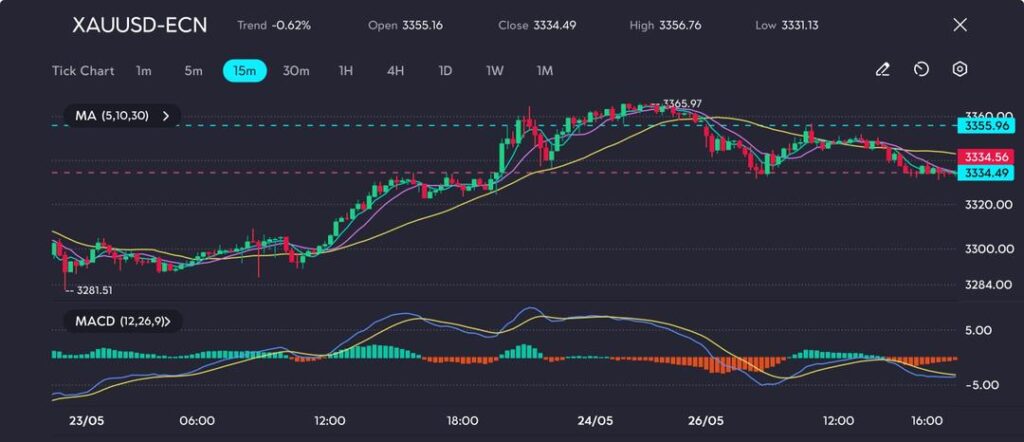
Gold eased at the start of the week as calming trade tensions reduced investor demand for safe-haven assets. After a strong rally driven by geopolitical risks and tariff fears, the market is now showing signs of consolidation. With slower activity and shifting sentiment, traders are watching for the next key catalyst.
Gold prices slipped on Monday as the easing of trade tensions reduced the metal’s appeal as a safe haven. Spot gold dipped 0.7% to $3,334.53 an ounce by 8:48 AM GMT, while US gold futures declined by 1% to $3,333.40.
The pullback marks a temporary halt in the precious metal’s six-week upward trend, which had been underpinned by escalating geopolitical concerns and tariff-related uncertainty.
Market sentiment shifted after US President Donald Trump reversed plans to introduce 50% tariffs on goods from the European Union starting 1 June. Instead, he reinstated a negotiation deadline for 9 July, alleviating one of the key drivers behind gold’s recent strength.
Giovanni Staunovo, commodities analyst at UBS, described the retreat as part of a “range-trading day”, attributing the mild losses to reduced tariff risk and thin trading volumes due to public holidays in both the US and UK. He suggested limited market activity may continue to suppress significant price movements in the short term.
Although the US dollar index slipped to its lowest level in nearly a month against a basket of major currencies, gold failed to benefit significantly from the dollar’s decline.
With global markets embracing a more risk-on tone, many investors began scaling back their exposure to traditional safe-haven assets like gold. This shift triggered profit-taking around the $3,360–$3,370 resistance band.
Nonetheless, Citi revised its short-term gold outlook, lifting its 0–3 month target to $3,500 per ounce—up from $3,150 earlier this month.
The upgrade reflects sustained concerns over the US fiscal position, lingering trade policy uncertainty, and ongoing geopolitical risks. Citi now sees gold trading within a broader range between $3,100 and $3,500 in the near term.
Meanwhile, geopolitical instability remains a looming variable. Russian forces launched a third consecutive night of airstrikes on Ukrainian infrastructure over the weekend, following Saturday’s attack that reportedly killed at least 12 civilians.
Although markets reacted with restraint, any further escalation could renew investor demand for gold if risk aversion intensifies.
From a technical perspective, gold rebounded from the $3,281.51 support level on 23 May, advancing steadily before topping out at $3,365.97 on 24 May.
This level has now become a short-term resistance zone, as bullish momentum faded and buyers failed to extend the rally.

The price has since shifted into a downward pattern, falling below short-term moving averages and forming a descending structure.
The MACD histogram has turned negative, and a bearish crossover confirms declining momentum. Gold is currently consolidating just above the $3,330–$3,335 support zone, which may provide a temporary floor.
However, unless the price can break back above $3,356, further downside towards $3,310 remains a possibility.
Gold is expected to remain in a narrow trading range in the short term, as the market digests recent shifts in global risk sentiment.
The temporary easing of trade tensions and lack of immediate geopolitical escalation have reduced the urgency for safe-haven buying, leading to a pause in the metal’s recent rally.
Traders should keep a close eye on key macroeconomic drivers, including developments in US tariff policy, updates on government spending plans, and fluctuations in the US dollar index—all of which could act as near-term catalysts.
Unless a clear directional trigger emerges, price action is likely to stay confined within the $3,310 to $3,360 zone over the next few sessions, reflecting a broader period of consolidation following recent highs.
Click here to open account and start trading.